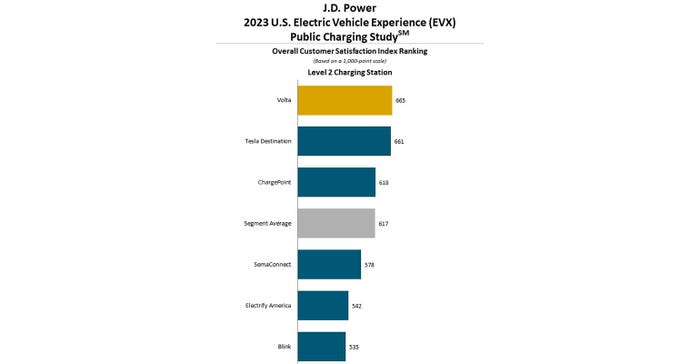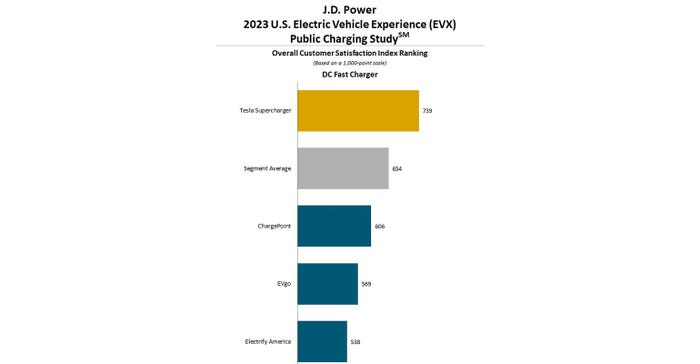Study: Public Charging Issues Are a Brake on EV Expansion
Volta, Tesla Supercharger rank highest in respective segments—but overall satisfaction has declined, says a new JD Power report.
August 23, 2023

As automakers persist in launching new electric vehicles (EVs) and achieving market share growth, the struggling state of public vehicle charging infrastructure lags significantly behind. In fact, it appears to be slipping further from the mark. The recent decision to allow non-Tesla owners access to Tesla Superchargers might hold potential to alleviate the situation, yet this action might not be the ultimate solution as some propose. This is evident from the J.D. Power 2023 U.S. Electric Vehicle Experience (EVX) Public Charging Study, unveiled this week, which indicates an ongoing decline in overall satisfaction.
Despite the increasing number of public charging stations dispersed throughout the United States, customer contentment with public Level 2 charging has dwindled to 617 points on a 1,000-point scale. This marks a 16-point drop from the previous year and represents the lowest level since the study's inception in 2021. Even more concerning, the contentment with DC (direct current) fast chargers has plummeted even further, plummeting by 20 points to 654. Most troubling is the fact that satisfaction has dwindled in almost every aspect evaluated within the charging station segments.
Given that consumer doubts about the availability of public charging stations stand as the primary reason prospective vehicle buyers reject EVs, this declining performance could potentially exacerbate the obstacles faced by EV acceptance.
“The declining customer satisfaction scores for public charging should be concerning to automakers and, more broadly, to public charging stakeholders,” stated Brent Gruber, executive director of the EV practice at J.D. Power. “The availability of public charging stations is still a critical obstacle, but it isn't the only one. EV owners continue to have issues with many aspects of public charging, as the cost and speed of charging and the availability of things to do while waiting for their vehicle to charge are the least satisfying aspects. At the same time, the reliability of public chargers continues to be a problem. The situation is stuck at a level where one of every five visits ends without charging, the majority of which are due to station outages.”

Tesla owners are relatively satisfied with the Tesla Supercharger network (745), but when they go outside the network to use other public charging options, satisfaction declines by nearly 200 points (550). “With greater adoption of the North American Charging Standard (NACS) pioneered by Tesla, it may provide a boost in fast-charging satisfaction among owners of EVs from other brands as they begin to use Tesla’s Supercharger stations,” Gruber stated. “We’re monitoring whether the use of Tesla Superchargers by non-Tesla owners will affect satisfaction, but the move does help address charger scarcity and offer access to industry-leading reliable chargers. It’s just too early to tell if it can reach the satisfaction levels of Tesla owners who are already part of that fully integrated Tesla ecosystem.”
Key findings from the 2023 study:
Decrease in satisfaction with charging speed: EV owners are expressing growing discontent with the time it takes to charge their vehicles. Notably, the attribute related to the speed of charging has had a significant adverse impact on overall Level 2 satisfaction, showing a decline of 36 points compared to the previous year, reaching a score of 455. Interestingly, even users of DC fast chargers are not much more satisfied, as their contentment with charging speed dropped by 30 points to 588.
The necessity for strategic placement of public chargers: The preferences stated by EV owners when selecting a Level 2 or DC fast charger, along with the duration spent at the charging station, underscore the importance of placing public chargers where they can best serve their clientele. While both Level 2 and DC fast charger users prioritize convenience, the latter group also emphasizes the need for charging stations along planned road trip routes. DC fast charger users typically spend around 30 minutes charging their vehicles, aiming to resume their journey promptly. Gruber commented, "The data suggests that DC chargers, which offer faster charging, should be strategically positioned along travel routes, while Level 2 chargers, primarily used for convenient charging, should be conveniently accessible near frequented spots such as retail and entertainment venues."
Persistent challenges of non-charging visits, influenced by location: The study reveals that 20% of all users reported visiting a charger without actually charging their vehicles. This can be attributed to reasons such as non-operational chargers or long waiting lines. Notably, the Miami-Port St. Lucie-Ft. Lauderdale Combined Statistical Area (CSA) experienced the highest incidence of this issue, with 35% of visits resulting in non-charging situations. Comparable CSAs like Seattle-Tacoma, Denver-Aurora, and Dallas-Ft. Worth had 29% of visits ending in non-charging outcomes. On the other hand, the Cleveland-Akron-Canton CSA exhibited the lowest percentage of non-charging visits, with a failure rate of 12%.

"The results of this year's study should be very concerning to all those involved in the transition from gas-powered vehicles to electric vehicles," Gruber stated. “Although the majority of EV charging occurs at home, public charging needs to provide a much better experience across the board—not just for the users of today, but also to alleviate the concerns of skeptical future customers. A lot of work is underway to address these issues but there is certainly much more work to be done.”
Study rankings
Volta ranks highest among Level 2 charging stations, with a score of 665. Tesla Destination (661) ranks second and ChargePoint (618) ranks third.
Tesla Supercharger ranks highest among DC fast chargers for a third consecutive year, with a score of 739. It is the only DC fast charger brand to rank above the segment average.
The study, now in its third year, measures EV owners’ satisfaction with two types of public charge point operators: Level 2 charging stations and DC fast charger stations. Satisfaction is measured across 10 factors (in order of importance): ease of charging; speed of charging; physical condition of charging station; availability of chargers; convenience of this location; things to do while charging; how safe you feel at this location; ease of finding this location; cost of charging; and ease of payment.
The 2023 U.S. Electric Vehicle Experience (EVX) Public Charging Study is driven by a collaboration with PlugShare, the leading EV driver app maker and research firm. The study examines consumer attitudes, behaviors and satisfaction, setting the standard for benchmarking the overall experience of public EV charging. Respondents included 15,079 owners of battery electric vehicles (BEVs) and plug-in hybrid electric vehicles (PHEVs). The study was fielded from January through June 2023.
For more information about the U.S. Electric Vehicle Experience (EVX) Public Charging Study, visit https://www.jdpower.com/business/automotive/electric-vehicle-experience-evx-public-charging-study.
About the Author(s)
You May Also Like



